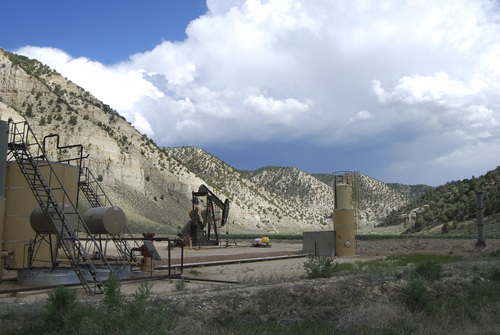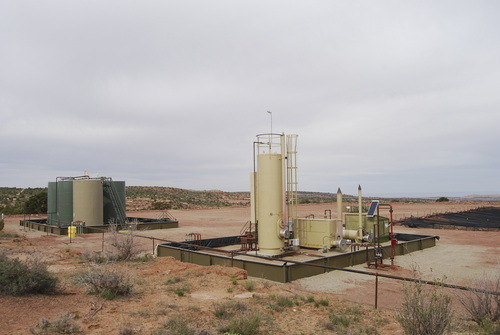This is an archived article that was published on sltrib.com in 2014, and information in the article may be outdated. It is provided only for personal research purposes and may not be reprinted.
A majority of the oil and gas wells drilled on federal land in Utah during recent boom years have not been inspected, according to data obtained by The Associated Press.
Of even more concern: Two-thirds of the wells the Bureau of Land Management (BLM) identified as high priority — because their locations pose greater risks — have not been examined.
The Utah data cover the 2,432 oil and gas wells drilled between 2009 and 2012 on Utah lands administered by the U.S. Forest Service, the BLM and the Bureau of Indian Affairs. Less than 20 percent of these were inspected.
Of the 327 high-priority wells, which BLM rules say should be inspected while they are being drilled, only 108 were visited by inspectors.
Some of the high-priority wells may have been downgraded as oil fields developed without problems. BLM officials said, but they concede some fall through the cracks because of budgetary constraints and the difficulty of retaining qualified inspectors.
BLM's Vernal office, the nation's busiest for energy development, sees half of its petroleum engineering technicians turn over every year, lured away by the much higher salaries offered by the industry, according to Kent Hoffman, the BLM's deputy state director over minerals.
Currently, all 17 of the office's positions for these key compliance officials are filled. But "this is the first time since 2006. We would usually have had three, four, five vacancies," Hoffman said.
The starting annual salary for these jobs runs up to $35,000, but by the time inspectors are certified they are worth double or triple that pay to industry.
BLM officials say they want to increase the compliance staff, but funding is not available and Congress won't give the agency authority to raise drilling permit fees to pay for inspections.
—
Skipped inspections • Former BLM staffers say the inspection data indicate the agency has emphasized issuing permits for drilling applications at the expense of environmental safety.
"There is a rush to approve unprecedented levels of oil and gas drilling on public lands and there's clearly very lax oversight," said Daniel Patterson, now the Southwest regional director of Public Employees for Environmental Responsibility. "The rhetoric of responsible energy development doesn't match the reality. Talk is cheap. It doesn't inspire confidence."
The data were compiled by the AP from the Automated Fluid Minerals Support System, the central database that the BLM uses to track oil and gas information.
The majority of Utah's uninspected wells are in the Uinta Basin, overseen by the Vernal field office. There are two clusters of about 20 wells each north of the White River and west of Bonanza on oil fields operated by EOG Resources.
Other operators with many uninspected wells are Bill Barrett Corp. and Newfield Exploration Co., Utah's two busiest energy developers.
The inspections confirm operators' compliance with the terms of their drilling permits and check the integrity of the bore hole and cement casings.
"They should be inspected sooner. If they don't have the resources to do inspections then go out and hire more inspectors," Patterson said. "There's is certainly a lot of money being made. We don't know if there might be a problem with installation. The agencies have a responsibility to permit levels of drilling that they can monitor."
Hoffman said he agrees. "Inspection and enforcement is a top critical priority," he said.
—
Setting priorities • The BLM identifies priority wells according to geological hazards, the potential for blowouts, design deficiencies, the rig operators' experience and track record, and proximity to valuable surface resources, such as rivers and parks.
High-priority wells should all be inspected, while the agency aims to inspect as many low priority wells as possible — about one in five.
"It's an unfortunate necessity we have to strategize in that way due to resource issues," BLM spokeswoman Megan Crandall said.
The AP data mirror conclusions reached by the Government Accountability Office (GAO) in numerous reviews over the past decade that found oversight is lacking. The slow pace of inspections has coincided with an influx of parcels nominated for oil and gas leases and drilling permit applications from industry, thanks to technological advances that have made more oil and gas deposits accessible.
Utah field offices approved 965 drilling permits last year, a record number, on top of the 848 approved the year before. And the number of producing federal leases is near an all-time high, at 1,473 leases on 1.1 million Utah acres involving 8,459 wells, according to BLM statistics.
Federal lands in Utah have never before seen this level of oil and gas activity, yet industry often complains that BLM is too slow to lease and process drilling applications.
Critics, however, say the BLM should be given the resources it needs to provide adequate oversight before approving more development. Industry, meanwhile, is sitting on nearly 1,800 approved but unused drilling permits in Utah, while the BLM is working through a backlog of 1,500 applications.
Stan Olmstead, a former staffer in the BLM's Vernal office, said the agency's approach is "backward."
It believes "permits are most important, leasing is next, compliance third, and reclamation fourth," Olmstead said. "Reclamation should be first. All wells no longer in production should be dealt with. Permitting should be the last thing you do, but it's where the money is."
It would free up resources if the BLM would require companies to properly retire their old non-producing wells, which still require the attention of inspectors, before awarding them new permits, Olmstead suggested.
He provided The Salt Lake Tribune a list of 355 Utah wells that had been idle for 10 or more years as of 2012, but have yet to be plugged and reclaimed.
—
Failing to keep up • A May GAO report said that the BLM has failed to update its inspection procedures to reflect technological advances that have transformed the oil and gas business. The agency also does not coordinate inspections with state regulators in Utah and three other states, the GAO added.
Industry representatives pointed to these findings to argue states are better positioned to oversee wells than the feds.
"They are better resourced and have a greater understanding of the varying geology throughout their region," said Tim Wigley, president of Western Energy Alliance. "Compared to BLM's outdated rules, states with significant production are effectively addressing risk by updating their rules to provide additional protections and encouraging the use of new technologies."
But Utah officials said their regulatory staffs are too small to help BLM much with its oversight duties.
"To say that we're going to start inspecting federal wells is just above and beyond what we could do," said John Rogers, associate director of the Utah Division of Oil, Gas and Mining.
He said companies inspect their own equipment to safeguard their investment, so it's likely that at least some of Utah's uninspected wells have been checked by someone.
The Associated Press contributed to this report.





